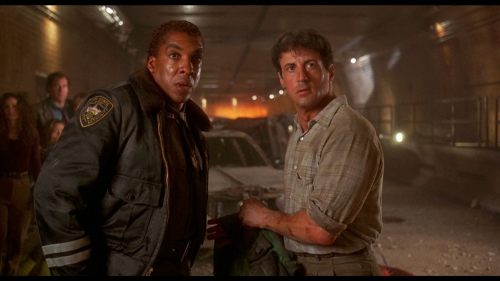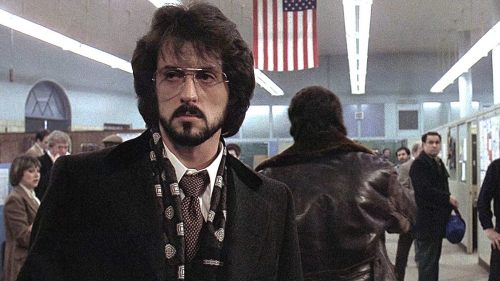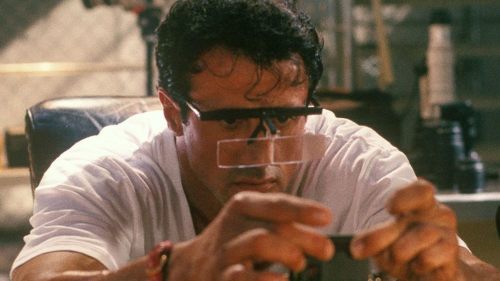Re-assessing RAMBO III: The Franchise Freezes As The Cold War Ends
As you may have heard, Alamo Drafthouse is doing an amazing Rambo marathon leading up to the release of 2019's greatest achievement, Rambo: Last Blood. Get your tickets here!
Rambo was always something of an accidental franchise. Certainly author David Morrell had no illusions about the character's longevity when he penned the novel First Blood — and closed it out with a very definitive death for its lead character.
And even though that rough ending was softened substantially by screenwriter/star Sylvester Stallone for the feature adaptation ten years later, it seems highly doubtful he or the producers could have imagined the pop culture dominance they’d achieve by turning Rambo from a tormented one-off into bona fide action hero.
Nevertheless, the success of director George P. Cosmatos’ Rambo: First Blood Part II in 1985 (at the box office, if not critically) opened the door to action figures, lunch boxes, a weekday animated show, and — perhaps the most important metric of all for a film’s success in the 1980s — regular mentions from the nation’s highest-ranking movie buff, President Ronald Reagan.
It was frankly a paradoxical place for the character to have ended up given his starkly anti-establishment origins as a pointed critique of American foreign interventionism, both on the page and onscreen. Although that sustained ardor made a third entry all but inevitable, it’s axiomatic that what goes up inevitably comes down, and this was true even when something burned as white-hot as Rambo did at his peak.
As such, by the time the next sequel arrived three years later, both the cultural and political zeitgeist had moved on. It turns out, Rambo’s appeal wasn’t transferable to any political hotspot on the planet. Placing him in Afghanistan during the waning days of the Soviet-Afghan conflict was a costly miscalculation, especially when carrying a $63 million budget that was (at the time) the biggest ever for a motion picture.
Although the threequel (directed by Peter MacDonald, himself stepping in for Highlander’s Russel Mulcahy, who departed the production after two weeks) comes up short in several key ways, it’s nonetheless a fascinating artifact of the era that produced it, and becomes even more fascinating when viewed not as the endpoint of the journey but simply one additional chapter in the Rambo cycle.
As scripted by Stallone and Sheldon Lettich, Rambo III (dispensing entirely with “First Blood” in the title, as if trying to will the audience to forget the character’s low-key origins) opens with Our Man John in Bangkok, stick fighting to earn money for monks building a monastery. There, Rambo is found by his old mentor Colonel Trautman (the late Richard Crenna, making his final appearance) to assist with an operation for the CIA in Afghanistan.
Rambo demurs — that monastery won’t build itself, after all — but Trautman persists, encouraging his former charge to “come full circle.” In this context, what Trautman really wants is for Rambo to recognize that he was born to be a warrior, and the only thing the good Colonel did was unleash what was already there (which, honestly, is a pretty messed up thing to say to a guy who’s doing everything he can to put the horrors of war behind him).
Regardless, what makes this exchange particularly noteworthy is how it signals the series’ shift from Rambo being a mere mortal to...something else. Someone divinely engineered to be a killing machine. (Contrast this with our introduction to Trautman in First Blood: “God didn’t create Rambo...I did.”) Anyway, Trautman proceeds without Rambo and things go predictably sideways.
Cut to Rambo making his way into Afghanistan to find a way to rescue his friend and father figure from the captivity of the boo-hiss Russkies (Russian to Trautman: Who do you think this man is, God? Trautman: No. God would have mercy). Spoiler: Rambo wins, and many things go boom along the way. MacDonald’s staging of the action is adequate if rarely exceptional, but audience familiarity with the characters works to the film’s advantage.
By this time Stallone had become so thoroughly established in the role that he really does manage a lot of the heavy lifting (literally and metaphorically) all by himself. He’s also helped along by the late composer Jerry Goldsmith's luxurious music score, which builds on the thematic material he’d already perfected with previous two entries.
In fact, Rambo III shows the extent to which the myth of Rambo’s invincibility — which had itself become a ready punchline during the peaks of the series’ popularity — began to permeate the films themselves. As an example, in First Blood, much is made of a bit where John stitches up his own arm following a fall from a helicopter onto some treetops. The scene is deliberately uncomfortable, showcasing the extent to which he learned survival skills in ‘Nam, and keeps things within the realm of believability. In contrast, Rambo III completes John’s journey from sad guy to Superman. After receiving a gaping wound to his torso, he seals it by pouring in gunpowder and lighting it — an act which should probably have blown an even bigger hole in his midsection. What would have seemed entirely ridiculous a mere six years earlier was now simply par for the course. It’s what you paid your admission to see.
Now, in a slightly awkward turn of events, Rambo engages in all of the movie’s explosion-filled antics while joining forces with the Afghan Mujahadeen fighters. They “don’t take any shit,” he says admiringly of them at one point. And sure, that may have made sense in a Cold War, “enemy of my enemy” late ‘80s calculus, but it would turn into a truly awkward position for the personification of American cinematic jingoism to occupy in a post-9/11 world. But while that would necessitate a few frantic conversations thirteen years down the line, at the time the depiction of the Afghan people as actual humans who are suffering and striving and struggling was something far removed from the usual Hollywood parlance, where the broad stereotypes of Muslim people offered by such fare as The Delta Force was far more common. (Says sympathetic Afghan leader Masoud, “Somewhere in the war there's supposed to be honor. Where's the honor here? Where?”)
In fact, as originally released it closed with a title card proclaiming, “This film is dedicated to the brave Mujahideen fighters of Afghanistan,” which was hastily changed after September 11 to a more broad dedication to “the gallant people of Afghanistan.” And though the filmmakers have had to step gingerly given the changes in geopolitics in the decades since, those geopolitics also make Rambo III such an interesting artifact today.
Arriving just as Glasnost was in the offing, the film fundamentally misread the immutability of Cold War tensions in structuring its story, both in terms of the audience’s growing affinity for the prospects of peace and their dwindling appetite for Rambo-scaled destruction. In hindsight, it’s entirely predictable that the project disappointed at the till, taking in nearly $100 million less domestically than its predecessor and putting the series into deep freeze for the next two decades.
The Rambo films have (perhaps inexplicably) retained a continued place of cultural prominence even as the specific historical context that produced the character recedes ever further into the distance. First Blood is the creative pinnacle. First Blood Part II is the cultural pinnacle. But Rambo III — as the sore-thumb “failure” in the accidental franchise — is an important point of demarcation worthy of re-assessment for all the many ways it stands apart.



